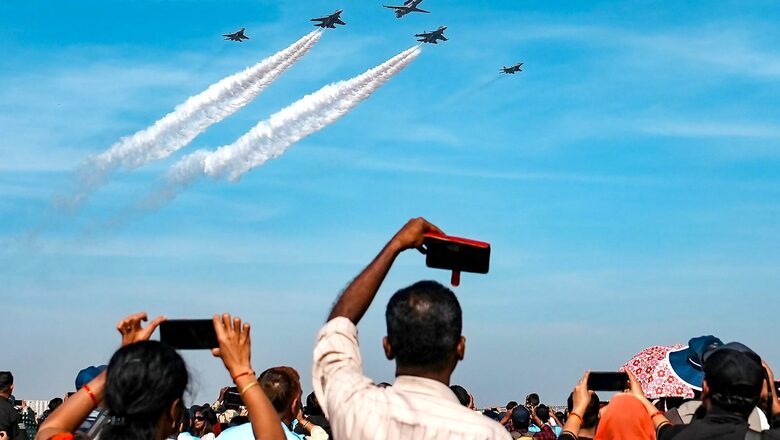
views
Aero India 2023, with its theme “The runway to a billion opportunities”, takes off today, 13 February, at Air Force Station Yelahanka, Bengaluru. It will continue till 17 February 2023. It will be the biggest air show in Asia with 731 exhibitors, including 98 foreign exhibitors from 30 different countries. Aero India began at Yelhanka in 1996 and this is the 14th iteration of the event. The event is meant to boost “Make in India” in the aviation sector. Prime Minister Narendra Modi will inaugurate the event.
Airshows evolve
An airshow or air tattoo is a public event where aircraft and related sub-systems are exhibited. It could be a dedicated military, civil aircraft show, or a combination. Air shows include a static display and aerial aerobatic demonstrations. It is held at an airbase where a large area is available for aircraft and equipment parking. The magnitude of the airshow is measured by the size of exhibit space and the number of exhibitors. The first public international airshow, at which many types of aircraft were displayed and flown, was the Grande Semaine d’Aviation de la Champagne, France, held August 22-29, 1909 in Reims. Before World War II, air shows were associated with long-distance air races, often lasting many days and covering thousands of miles.
Air races
The first ‘heavier-than-air’ air race was held on 23 May 1909 – the Prix de Lagatinerie, at the Port-Aviation airport south of Paris, France. It meant flying ten 1.2 kilometres laps. The 1909 event at Reims was the first major international flying event. The first Gordon Bennett Trophy was won by Glenn Curtiss. In 1913, the first Schneider Trophy seaplane race was held. After WW I, in October 1919, the US Army Transcontinental Air Race (4,345 km) was flown from Long Island, New York to San Francisco, California, and back. In 1921, the United States instituted the National Air Meets, which became the National Air Races in 1924. The National Air Races lasted until 1949. In 1934, the MacRobertson Air Race was flown from England to Australia. The National Championship Air Races were soon moved to the Reno Stead Airport, and have been held there every September since 1966. Some other promoters have run pylon racing events across the US and Canada.
In 2003, Red Bull created a series called the Red Bull Air Race World Championship, in which competitors flew individually between pairs of pylons, while performing prescribed manoeuvres. In 2019, Red Bull decided not to continue the Red Bull Air Race World Championship.
Flying circus
In the inter-war years, Sir Alan John Cobham, an English aviator, began what came to be known as “Cobham’s Flying Circus”. In 1932 he started these “National Aviation Day” displays. These consisted of a team of up to fourteen aircraft, ranging from single-seater aircraft to modern airliners, and many skilled pilots. It toured the country, calling at hundreds of sites, some of them regular airfields and some just fields cleared for the occasion. These were highly popular, giving thousands of people not only their first sight of an aircraft but in some cases their first experience of flying. The flying display included formation flights, aerobatics, daring parachute descents, till then unique upside-down flying, glider aerobatics, wing-walking stunts, and stunts like picking a hanky on the ground with a hook attached to the aircraft wing-tip. With the approval of the Air Ministry and the support of the entire aeronautical community, the displays were held over hundreds of towns. These were a source of inspiration for countless pilots in the Second World War.
Major airshows
Among the bigger airshows are those held at Le Bourget (Paris), Farnborough (UK), Dubai and Singapore. The other big shows include the MAKS airshow in Moscow, China International Aviation & Aerospace Exhibition (Zhuhai), and Aero India (Yelahanka). The largest airshow or fly-in by number of participating aircraft is EAA AirVenture Oshkosh, with approximately 10,000 aircraft participating annually, 650,000 visitors, and 1400 forums, workshops, and presentation sessions. The Royal International Air Tattoo (RIAT) is the world’s largest military air show, held annually in July, usually at RAF Fairford in Gloucestershire, England in support of The Royal Air Force Charitable Trust. The show typically attracts a total of 150,000 to 200,000 spectators over the weekend. Airshows in each country are held during good weather season. The larger airshows also have formation aerobatic teams participating such as the United States Navy Blue Angels, United States Air Force Thunderbirds, Royal Air Force Red Arrows, Indian Air Force Surya Kiran and Sarang.
Aircraft flying demonstrations
Most countries showcase their latest aircraft capabilities through solo military demos. The display includes demonstrating the aircraft’s short take-off rolls, fast climbs, high speeds, ability to make tight turns, display precise control at a large range of speeds, and slow approach speeds. Russian fighters with thrust vectoring may perform the cobra manoeuvre, while VTOL aircraft such as the Harrier may display vertical capabilities. Some military aircraft might show two aircraft combat manoeuvring.
Flight and ground safety
Since most aircraft are showcasing limits of their performance at low levels, with large human gatherings, flight safety becomes even more important. Each airshow has a flight display director (FDD). FDD formulates the rules for the air display. The no-crossing lines are demarcated and briefed. Display minimum heights are stipulated. The entire display is continuously video graphed by multiple cameras. Every morning all the participating aircrews attend a combined briefing on weather and safety aspects and are briefed by the FDD. The FDD director can stop any inflight display if he feels any limit has been, or is likely to be, breached.
Most company stalls are in temporary large exhibition halls. A very large number of visitors come to these halls. There is extensive lighting and air-conditioning in these halls. Many halls have food heating arrangements. Also, a large number of vehicles are parked. There is thus a risk of fire and appropriate measures are required for safety.
Major airshow accidents
While airshows are intended to showcase and encourage aviation and also to provide a fun time for the family, unfortunately, disasters have occurred over the years, creating safety risks for spectators and aviators. During the 2002 Sknyliv Air Show in Ukraine, a Sukhoi Su-27 crashed during an aerobatic manoeuvre killing 77 people and injuring 543, making it the deadliest air show accident in history.
In August 1988, during an airshow at the United States Ramstein Air Base in West Germany, three airplanes from the Italian Air Force display team collided and crashed to the ground. The planes hit the runway and created a fireball that tumbled into the spectators. Three pilots and 67 spectators died from the crash and close to 500 people had to seek hospital treatment due to the event.
A Tupolev TU-144 supersonic airliner disintegrated in the air at the Paris airshow in 1973 which resulted in 14 deaths. At the airshow in Bengaluru in 2019, two Surya Kiran jets collided mid-air during Aero India rehearsal, killing one pilot. Overall the safety record is fairly good, and the best professionals are engaged in the air display.
Seminars and conferences
Many foreign defence delegations come for the airshows. There are Defence Ministers’ meetings, Air Chiefs Conclave, and Aeronautical scientists from DRDO and HAL make presentations. There are media briefings at a specially set up media centre. There are interactions between think tanks. Many media partners come out with show-dailies covering the briefings and press releases. There are social events such as lunches and dinners. Airshows are one place for all from the aviation community to network and exchange information.
Business interactions
Airshow is a place for showcasing and marketing aviation-related products. Industry gets to meet senior government and military officials, and take them to their stalls to brief on products. Many delegations that visit the airshow have decision-making powers. Airshows are also used to announce big deals that have earlier been under negotiation. Working-level aviation specialists from the armed forces get exposed to many in the industry.
India’s thrust for aatmanirbharta (self-reliance) is likely to see more industries wanting to set up production facilities in India. Big international aviation companies like Boeing, Lockheed Martin, General Electric, British Aerospace, Airbus, among others are already in India, and are expanding operations.
Aviation fest for students and public
The airshow is a great fest for aviation enthusiasts, school children, and local families who come to the event in large numbers. While the first few days are reserved for professional interactions, the last two days are meant for the public.
Airshow is a great occasion to popularise aviation and the many employment opportunities it provides to designers, scientists, technicians, metallurgists, sheet metal workers, technologists, among many others working on or near aircraft. Many aviation colleges give exposure to their students. Post Covid-19, the number of visitors are likely to be high, as India is looking forward to its greatest aviation event in mid-February.
The writer is Director General, Centre for Air Power Studies. Views expressed are personal.
Read all the Latest Opinions here




















Comments
0 comment